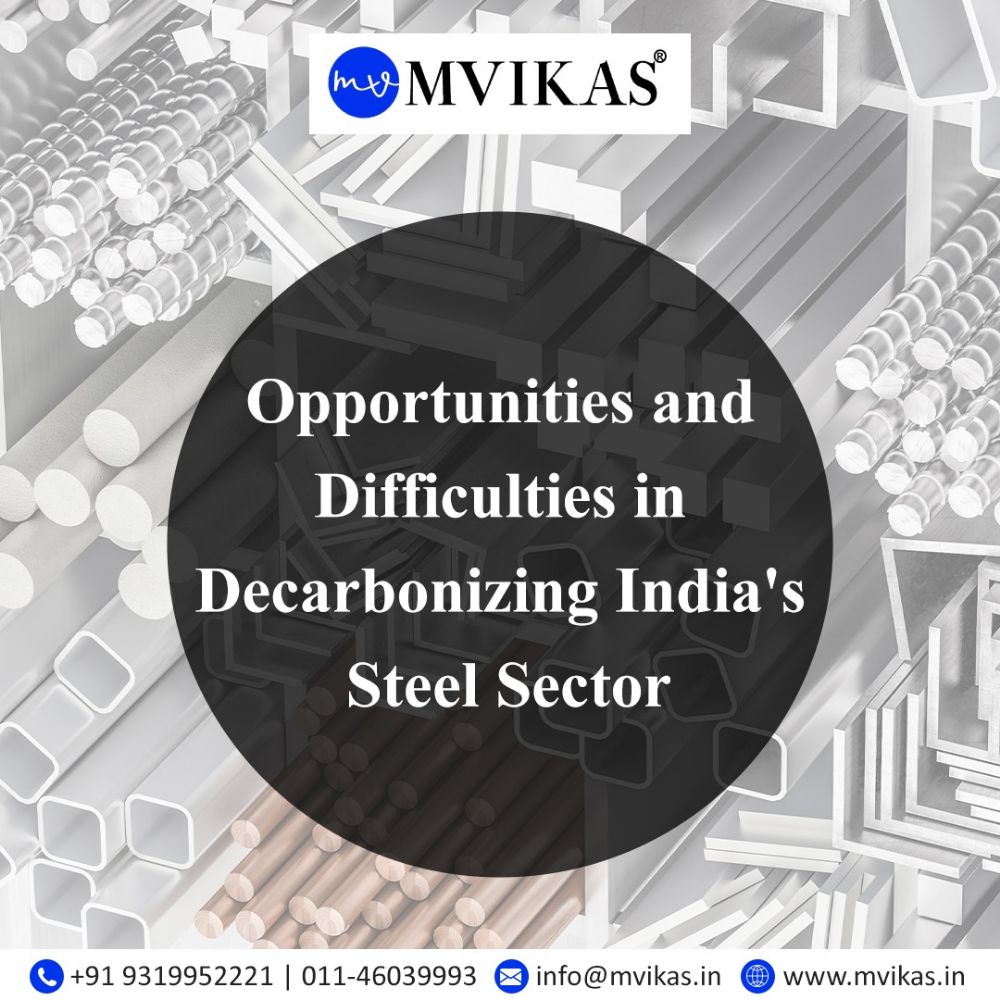Reachable at 9560662883  011-46039993 (Ext. 21 to 32) (10am - 06pm)
011-46039993 (Ext. 21 to 32) (10am - 06pm)
Opportunities and Difficulties in Decarbonizing India's Steel Sector

The steel sector is responsible for 7% of the nation's greenhouse gas emissions and 2% of the GDP. With expanded production to fulfill local and international demand, the present annual carbon dioxide (CO2) emissions from the steel industry are predicted to grow from 242 Mt to double by 2030 and treble by 2050. Decarbonizing the steel industry is significant from the standpoint of the global regulatory environment that is now developing.
Meaning of Decarbonizing
The sector might be largely decarbonized if hydrogen produced from renewable energy (Green Hydrogen) replaced coal. The cost of steel would increase if hydrogen took the place of coal at the present pricing levels. It is the reverse of carburization in that it involves decreasing carbon concentration. Decarbonizing the steel industry is significant from the standpoint of the global regulatory environment that is now developing.
The phrase is frequently used in metallurgy to describe a reduction in the carbon content of metals (usually steel). It usually happens when steel is heated over the temperature at which it will recrystallize, typically approximately 700 degrees Celsius.
Large Vs Small Producers
Broadly diverse decarbonization outlooks in the forthcoming years reflect the variations between small and large plants. About 63% of the overall output is made by large steel companies serving a global market. Thus, they must be receptive to new global market efforts and developments like the EU's Carbon Border Adjustment Mechanism (CBAM), which is anticipated to influence India's steel exports substantially. These programs encourage green steel as a transitional material to stay up with global market trends.
The market and technological competence of around six major corporations enable them to look for finance for new, more adequate facilities. However, they will primarily be installing new BF-BOF technology because of the scarcity of recovered scrap, the geographic distance from natural gas, and the necessity to grow output on a massive scale. The domestic market, which is very sensitive to price fluctuations, is served by smaller facilities.
These producers will likely continue using coal since decarbonization is less tempting to them because it might harm their business line.
What is the target of Decarbonization of Steel Industry?
The ultimate goal is to attain carbon neutrality or restore atmospheric CO2 levels that existed naturally before human involvement. At the COP26 last year, India declared its intention to achieve net-zero emissions by 2070. It will be the final significant economy to arrive. In addition to pledging to use half of installed power capacity from non-fossil fuel-based energy by 2030, it also aims to reduce emissions intensity by 45% from 2005.
How is India planning to Decarbonization the steel industry?
To be carbon neutral, one must strike a balance between generating and absorbing carbon in carbon sinks. Carbon sequestration is removing carbon dioxide from the atmosphere and storing it later. Globally, there are several essential options for decarbonizing the steel industry, including integrating carbon capture and storage systems into fossil fuel-powered processes. Using clean hydrogen to direct power reduction and increasing the amount of material produced from recycled scrap in electric arc furnaces with clean energy.
What are the main Decarbonization Strategies?
Using three key strategies—optimize, electrify, and decarbonize—can enable nations to satisfy their energy demands while emitting zero carbon dioxide. Energy efficiency, industrial electrification, low-carbon fuels, feedstock’s, and energy sources (LCFFES), and carbon collection, utilization, and storage are the four pillars of cross-cutting decarbonization (CCUS). We can decarbonize our economy by addressing the four pillars of energy efficiency, low carbon energy, fuel switching, and non-energy emissions, including enhancing land carbon storage.
This emissions reduction goal was created following the decarbonization necessary to keep the increase in global temperature to 1.5 or well below 2 degrees Celsius.
Why is Decarbonizing Steel difficult?
Due to their high heat demands, use of carbon as a process ingredient, poor profit margins, high capital intensity, long asset lives, and trade barriers, iron, and steel are among the most challenging sectors to decarbonize. The top three carbon-emitting industries are steel, cement, and chemicals, which are also among the hardest to decarbonize due to technical and economic factors.
Technical factors include the need for very high heat and process emissions of carbon dioxide, as well as low-profit margins, capital intensity, long asset lives, and trade exposure. When limestone is heated to extremely high temperatures to form calcium oxide "clinker," the main component of cement, this chemical reaction also results in the emission of CO2 in the cement-making process.
Although other materials may be added to clinker without affecting cement quality, capturing CO2 and storing it or finding its purpose is the foremost strategy for decarbonizing the industry. The chemical industry is distinct from the other two since it includes many processes and goods. But more than 90% of "organic," or carbon-containing, compounds come from a small number of fundamental constituents that are mass-produced and sold globally.
Greater Efforts to reduce carbon emissions
The steel industry in India has come under increasing pressure to accelerate decarbonization in recent years. The Industrial Deep Decarbonization Institute (IDDI), a global alliance of groups striving to improve demand for low-carbon industrial commodities, including steel, is co-chaired by India. IDDI collaborates with national governments to promote investment in low-carbon practices and standardize decarbonization techniques, such as carbon assessments. Prime Minister Narendra Modi has declared a net-zero emissions target by 2070, which aligns with these objectives.
The 2017 National Steel Policy, which focuses specifically on the steel sector, intends to support industrial growth by doubling output by 2030, boosting per capita consumption, and lowering carbon dioxide emissions intensity.

Leave your comment